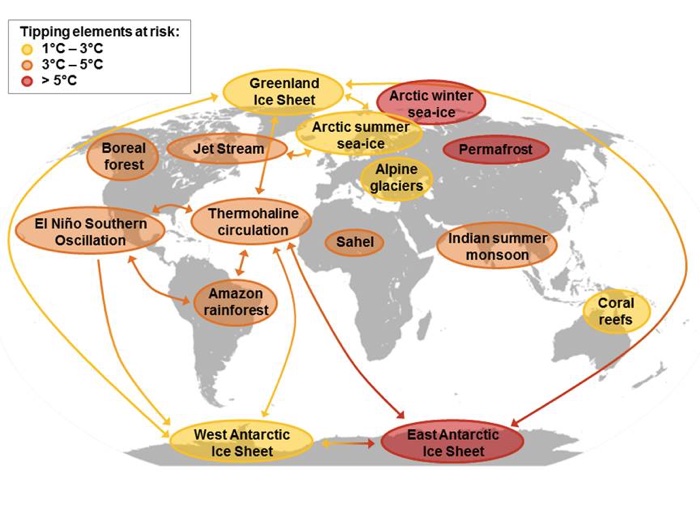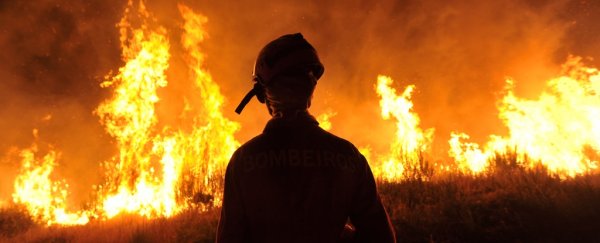The coasts are gone. The waves crash high into what were once mountains. Many have perished, for food is scarce, and the deadly heat is inescapable.
This bleak future scenario – called a "Hothouse Earth" – could be realised sooner than we think, scientists warn, if the planet breaches a pivotal climate threshold from which there may ultimately be no coming back.
The worst part? Scientists say we could exceed this threshold even if we meet the carbon emission reductions called for in the Paris Agreement – and manage to keep global temperatures to 2°C above pre-Industrial levels.
Achieving that goal would be a global success story. But it might not be the end of the story.
"Human emissions of greenhouse gas are not the sole determinant of temperature on Earth," says Earth system scientist Will Steffen from the Australian National University.
"Our study suggests that human-induced global warming of 2°C may trigger other Earth system processes, often called 'feedbacks', that can drive further warming – even if we stop emitting greenhouse gases."
In a new perspective study, Steffen and an international team of researchers outline a number of these 'positive feedback' systems that exist on Earth and can "amplify a perturbation and drive a transition to a different state".
In science, negative feedback systems maintain equilibrium in a given setting, but positive feedback systems do the opposite – exacerbating changes that are already underway.
One example is permafrost thaw. As the world gets hotter due to heat-trapping carbon emissions, there's worrying evidence that melting permafrost soils are releasing even more carbon into the atmosphere – making a bad situation potentially catastrophic.
That's just one example the new study looks at, in addition to several others, including the loss of methane hydrates from the ocean floor, weakening land and ocean carbon sinks, and increasing bacterial respiration in the oceans.
None of these trends are looking good, and the team says as the world gets hotter, hitting 2°C could well be the point where it becomes difficult or impossible to reverse these dangerous feedback loops.
"These tipping elements can potentially act like a row of dominoes," explains co-author Johan Rockström from the Stockholm Resilience Centre in Sweden.
"Once one is pushed over, it pushes Earth towards another… Places on Earth will become uninhabitable if 'Hothouse Earth' becomes the reality."
 (Stockholm Resilience Centre)
(Stockholm Resilience Centre)
The researchers are eager to emphasise that it's impossible to say for sure whether a global temperature rise of 2°C above pre-Industrial levels is the exact point we'd pass the threshold – as we're in uncharted territory here.
But the study is designed to point out that the less-optimistic goal of the Paris Agreement may not be the safe haven or environmental 'truce' many assumed it was – as by then it may already be too late, with human activity having triggered numerous runaway effects beyond our control.
"We note that the Earth has never in its history had a quasi-stable state that is around 2°C warmer than the pre-Industrial and suggest that there is substantial risk that the system, itself, will 'want' to continue warming because of all of these other processes – even if we stop emissions," one of the team, Katherine Richardson from the University of Copenhagen in Denmark, told The Guardian.
So what's the answer? Well – apart from more holistic research to refine our understanding of where and when this threshold to catastrophe is located – nothing short of a complete reimagining of our role on (and relationship to) Planet Earth.
"Collective human action is required to steer the Earth System away from a potential threshold and stabilise it in a habitable interglacial-like state," the authors explain in their paper.
"Such action entails stewardship of the entire Earth System –biosphere, climate, and societies – and could include decarbonisation of the global economy, enhancement of biosphere carbon sinks, behavioural changes, technological innovations, new governance arrangements, and transformed social values."
Okay, so they're asking for a lot, but is the alternative preferable: a stabilisation of extreme environmental conditions where temperatures increase up to 5°C hotter than pre-Industrial temperatures? Bringing with it sea level rises of 10–60 metres, in turn destroying coastlines, agriculture, our ability to govern, and ultimately to survive?
It's not all bad news, though.
"Some signs are emerging that societies are initiating some of the necessary transformations," the researchers write.
"However, these transformations are still in initial stages, and the social/political tipping points that definitively move the current trajectory away from Hothouse Earth have not yet been crossed, while the door to the Stabilised Earth pathway may be rapidly closing."
The researchers don't pretend to have all the answers, and they acknowledge that their 2°C threshold is a largely hypothetical marker.
But in light of everything we're learning about the perilous state the world is in – again and again and again – it should come as a surprise to precisely nobody at all that the stakes are this terrifyingly high.
"In the context of the summer of 2018, this is definitely not a case of crying wolf," climate researcher Phil Williamson from the University of East Anglia, who wasn't involved in the study, told The Guardian.
"The wolves are now in sight."
The findings are reported in Proceedings of the National Academy of Sciences.
